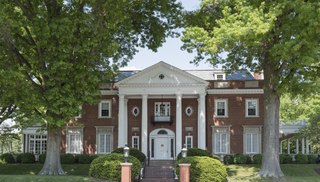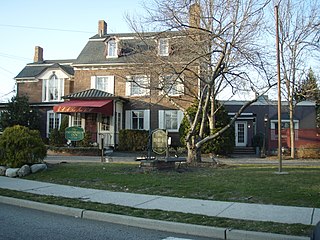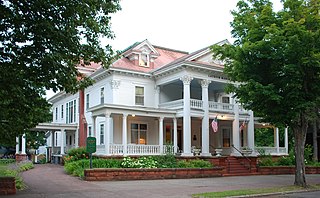
The Finger Lakes are a group of eleven long, narrow, roughly north–south lakes located directly south of Lake Ontario in an area called the Finger Lakes region in New York, in the United States. This region straddles the northern and transitional edge of the Northern Allegheny Plateau, known as the Finger Lakes Uplands and Gorges ecoregion, and the Ontario Lowlands ecoregion of the Great Lakes Lowlands.

Aurora, or Aurora-on-Cayuga, is a village and college town in the town of Ledyard, Cayuga County, New York, United States, on the shore of Cayuga Lake. The village had a population of 724 at the 2010 census.

Wells College is a private liberal arts college in Aurora, New York. The college has cross-enrollment with Cornell University and Ithaca College. For much of its history it was a women's college.
Pleasant T. Rowland is an American educator, reporter, writer, entrepreneur and philanthropist. Rowland is best known for creating the American Girl brand.

The Steuben House is a noted example of Bergen Dutch sandstone architecture, located at New Bridge Landing on the Hackensack River in River Edge, in Bergen County, New Jersey, United States.

Edwin Barber Morgan was an entrepreneur and politician from the Finger Lakes region of western New York. He was the first president of Wells Fargo & Company, founder of the United States Express Company, and director of American Express Company. He was elected to the United States House of Representatives from New York and served for three terms.

The West Virginia Governor's Mansion is a historic residence located next to the Kanawha River in Charleston, West Virginia and is the official residence of the governor of West Virginia.

Ho-Ho-Kus Inn is a historic landmark that is currently a restaurant located in Ho-Ho-Kus, New Jersey, United States, at the intersection of Franklin Turnpike, Maple Avenue, and Sheridan Avenue. Its name was taken from a Delaware Indian term meaning "the red ceder". Established in 1790, The Ho-Ho-Kus Inn was once known as The Mansion House and consists of five rooms: Chateau, Crystal, Hermitage, Tap, and Zabriskie.
Happyland is a satirical novel written by J. Robert Lennon about a town in upstate New York that is taken over by a doll maker. Some have interpreted the plot as an account of American Girl founder Pleasant Rowland's attempt to develop the village of Aurora, Cayuga County, New York, into a quaint tourism destination. The novel also features a women's college, very much like Rowland's alma mater Wells College and portrays it as a center of lesbian activity.
West Park is a hamlet on the west side of the Hudson River in the Town of Esopus, Ulster County, New York, United States. During the nineteenth and early twentieth centuries, the area became attractive to the well-to-do seeking second homes because it provided privacy, clean water and relatively inexpensive property.

The Aurora Inn is a historic building in Aurora, Cayuga County, New York. It was built in 1833 for Edwin B. Morgan, a local businessman involved in trade and shipping on Cayuga Lake. It is a contributing property in the Aurora Village-Wells College Historic District which in 1980 was listed on the National Register of Historic Places.
The historic village of Aurora, Cayuga County, New York, rises on a hill above the eastern shore of Cayuga Lake. The village was named by Captain Benjamin Ledyard, who settled there in 1793, in the post-Revolutionary development of the Finger Lakes region. Up until the mid-nineteenth century, Aurora played an important part in the history of Central New York.
William Henry Miller (1848–1922) was an American architect based in Ithaca, New York.
Leland Castle is a building in New Rochelle, New York. It was constructed during the years in 1855 - 1859 in the Gothic Revival style, and was the country residence of Simeon Leland, a wealthy New York City hotel proprietor. Leland began to assemble an estate as early as 1848, and in 1855, began the erection of this palatial 60-room mansion. The home was designed by New York City architect William Thomas Beers. A north and south wing were added to the castle in 1899 and 1902 respectively.

The Thomas H. Hoatson House is a house located at 320 Tamarack Street in Laurium, Michigan. It was listed on the National Register of Historic Places in 1994. At 13,000 square feet (1,200 m2), it is the largest mansion in the western Upper Peninsula of Michigan.

Aurora Steam Grist Mill was a historic grist mill located in Aurora, Cayuga County, New York. It was a monolithic, 3+1⁄2-story rectangular stone structure built on the shore of Lake Cayuga. It was one of the first mills built west of the Hudson River to be powered by steam. In 1974, the building's roof collapsed due to neglect and plans were to restore it for use as a community center. It was largely intact until 1992, when Wells College began to demolish it in order to build a dock behind the Aurora Inn.
MacKenzie-Childs, Ltd. is a manufacturer of ceramics and home decor retailer. The company is based in Aurora, New York, and was founded in 1983 by Victoria and Richard MacKenzie-Childs.

Rogues' Harbor Inn, formerly known as the Elm Grove Inn and Central Exchange Hotel, is a historic inn and tavern located in Lansing, New York. The building was listed on the National Register of Historic Places in 2009 and is located on the eastern shore of Cayuga Lake in the Finger Lakes region of Upstate New York, approximately eight miles from Ithaca.

Rose Terrace was a private home located at 12 Lake Shore Drive in Grosse Pointe Farms, Michigan. Built in 1934 by Anna Dodge, widow of automobile pioneer Horace E. Dodge, it was designated a Michigan State Historic Site in 1971 and listed on the National Register of Historic Places in 1971. Despite this, the house was demolished in 1976.

The campus of Bard College comprises 1,000 acres (400 ha) in Annandale-on-Hudson, New York. The campus, situated on the east shore of the Hudson River, offers sweeping views of the Catskill Mountains and is within the Hudson River Historic District, a National Historic Landmark. Almost all campus buildings built prior to 1950 are listed on the National Register of Historic Places as contributing features to the historic district.

















